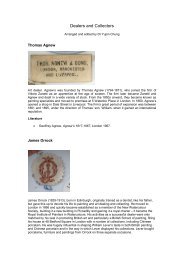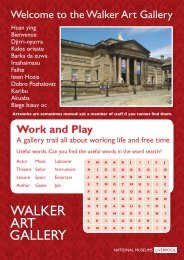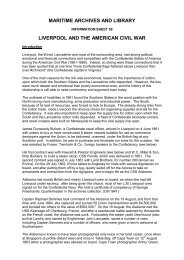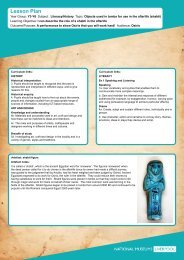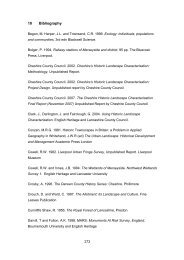museum guide and floorplan - National Museums Liverpool
museum guide and floorplan - National Museums Liverpool
museum guide and floorplan - National Museums Liverpool
Create successful ePaper yourself
Turn your PDF publications into a flip-book with our unique Google optimized e-Paper software.
Life in West Africa<br />
Enslavement <strong>and</strong> the Middle<br />
Passage<br />
Legacy<br />
GALLERY 1<br />
GALLERY 2<br />
GALLERY 3<br />
Stairs to floor 2 Stairs to floor 4<br />
Accessible toilets Emergency stairs<br />
Anthony Walker Education Centre<br />
<strong>and</strong> emergency stairs<br />
Toilets<br />
Lifts<br />
INTERNATIONAL SLAVERY MUSEUM FLOOR PLAN<br />
LOOKING TO THE FUTURE<br />
In 2011 the International Slavery<br />
Museum Research Institute <strong>and</strong><br />
Education Centre will open in the<br />
19th Century Dock Traffic Office next<br />
to Merseyside Maritime Museum.<br />
It will be connected to the galleries<br />
by an enclosed glass bridge <strong>and</strong> will<br />
provide an expansion of the current<br />
<strong>museum</strong>. Working in partnership with<br />
communities the centre will be a venue<br />
for a programme of public activities<br />
including temporary exhibitions,<br />
lectures, debates, performing arts,<br />
theatrical or musical events,<br />
demonstrations, book readings,<br />
<strong>and</strong> community events.<br />
If you would like to find out more<br />
about the project, or would like to<br />
support it visit<br />
www.liverpool<strong>museum</strong>s.org.uk<br />
GENERAL INFORMATION<br />
The International Slavery Museum is<br />
located on the third floor of Merseyside<br />
Maritime Museum.<br />
OPENING HOURS<br />
Open daily 10am - 5pm.<br />
All exhibitions, events <strong>and</strong><br />
activities are free.<br />
ENQUIRIES<br />
Please go to the information desk<br />
on the ground floor.<br />
ACCESS<br />
Level entry, accessible toilets <strong>and</strong><br />
wheelchair access throughout<br />
the building.<br />
Induction loops are fitted at various<br />
points throughout the <strong>museum</strong>.<br />
Guide <strong>and</strong> hearing dogs welcome.<br />
BABY CHANGING<br />
Available on the ground <strong>and</strong><br />
third floors.<br />
LOCKERS<br />
Available on the ground floor.<br />
Elsewhere please do not leave bags<br />
<strong>and</strong> belongings unattended.<br />
WHERE TO EAT<br />
Choose from a selection of food <strong>and</strong><br />
drinks at our cafés on the ground <strong>and</strong><br />
fourth floors. Please note eating <strong>and</strong><br />
drinking are not allowed on the<br />
galleries or in the foyer.<br />
MUSEUM SHOP<br />
Located on the ground floor, stocking<br />
a wide range of souvenirs <strong>and</strong> gifts<br />
including books, postcards <strong>and</strong> posters.<br />
PHOTOGRAPHY<br />
Photography is allowed for personal<br />
use but no flash or tripods please.<br />
Photography may not be allowed in<br />
certain areas - there will be notices<br />
advising you of this.<br />
FACILITIES<br />
International Slavery Museum<br />
Albert Dock, <strong>Liverpool</strong> L3 4AX<br />
Telephone 0151 478 4499<br />
www.liverpool<strong>museum</strong>s.org.uk<br />
MUSEUM GUIDE<br />
FREE ENTRY
WELCOME<br />
LIFE IN WEST AFRICA<br />
ENSLAVEMENT AND THE MIDDLE PASSAGE<br />
LEGACY<br />
The International Slavery Museum looks<br />
at both the historical <strong>and</strong> contemporary<br />
legacies of transatlantic slavery.<br />
It explores the reasons why millions of<br />
Africans were forced into slavery <strong>and</strong><br />
also the crucial role that the city of<br />
<strong>Liverpool</strong> played in that process.<br />
The <strong>museum</strong> has three main galleries:<br />
Life in West Africa, Enslavement <strong>and</strong> the<br />
Middle Passage, <strong>and</strong> Legacy.<br />
At the entrance to the International<br />
Slavery Museum is the Freedom <strong>and</strong><br />
Enslavement Wall, where you can watch<br />
interviews with a range of people, from<br />
community historians to people who<br />
have been enslaved, as they discuss their<br />
ideas of freedom <strong>and</strong> enslavement.<br />
Please note that some areas of the<br />
International Slavery Museum contain<br />
graphic images <strong>and</strong> exhibits which you<br />
may find distressing.<br />
Explore the story of Africa <strong>and</strong> its<br />
people <strong>and</strong> glimpse the richness <strong>and</strong><br />
importance of Africa’s long <strong>and</strong><br />
complex cultural history, before the<br />
start of the transatlantic slave trade.<br />
The gallery includes the recreation of<br />
an Igbo family compound.The most<br />
important building is the Obi or<br />
meeting house.<br />
All the carved wooden items <strong>and</strong><br />
furnishings for the compound were<br />
made by craftspeople in southeastern<br />
Nigeria in 2007. Much of the wall area<br />
of the compound is painted with bold<br />
<strong>and</strong> colourful designs traditionally<br />
painted by Igbo women for<br />
special occasions.<br />
Other objects on<br />
display in this gallery<br />
include African art<br />
forms that have had a<br />
global cultural influence<br />
such as musical<br />
instruments, masks <strong>and</strong><br />
sculpted figures.<br />
Reliquary guardian figure<br />
Mbulu ngulu Late 19th or early 20th century.<br />
Kota, Gabon. © International Slavery Museum<br />
This gallery reveals the brutality <strong>and</strong><br />
trauma suffered by enslaved Africans<br />
as they were taken to work on<br />
plantations in the Americas.<br />
At least 12 million Africans were<br />
enslaved over a period of 400<br />
years before transatlantic slavery<br />
was finally abolished.<br />
Sometimes enslaved Africans were<br />
forced to march for hundreds of<br />
miles from their homes to the<br />
coast. Sold several times over on<br />
this journey, they passed from one<br />
owner to another, their sense of<br />
disorientation <strong>and</strong> dread heightening<br />
with each sale.<br />
Once they reached the coast, they<br />
were taken on board ships <strong>and</strong> had<br />
to endure a horrific four to six<br />
week journey across the Atlantic in<br />
cramped <strong>and</strong> disgusting conditions.<br />
This part of their journey is<br />
described as the Middle Passage.<br />
On the ships many of the enslaved<br />
Africans died of disease <strong>and</strong> many<br />
took their own lives. Africans were held<br />
in atrocious dehumanising conditions.<br />
Violence, terror <strong>and</strong> degradation were<br />
everyday occurrences on board ship<br />
<strong>and</strong> they were treated equally<br />
inhumanely on arrival in the Americas.<br />
Slave Coffle, Sierra Leone, 1793<br />
© <strong>National</strong> Maritime Museum, London<br />
Headdress of cowrie<br />
shells with roan<br />
antelope horns, Kon<br />
Jombo, West Africa<br />
© International<br />
Slavery Museum<br />
Ken Saro-Wiwa.<br />
Lambon/Greenpeace<br />
This gallery includes displays <strong>and</strong><br />
exhibits which offer reminders of the<br />
racism <strong>and</strong> discrimination faced by<br />
Black people even after the abolition<br />
of the slave trade.<br />
Transatlantic slavery has left a<br />
damaging <strong>and</strong> dangerous legacy of<br />
racism <strong>and</strong> discrimination which has<br />
affected the development of all the<br />
countries involved.<br />
In particular many African, Caribbean<br />
<strong>and</strong> South American countries have<br />
faced long-term underdevelopment<br />
because of slavery <strong>and</strong> colonialism.<br />
In this gallery you can also<br />
discover examples of how the<br />
unquenchable spirit of people of<br />
African descent has helped to<br />
shape the society <strong>and</strong> cultures<br />
of the Americas <strong>and</strong> Europe.<br />
Four centuries of revolts <strong>and</strong> revolution<br />
are examined on the Fight for Freedom<br />
<strong>and</strong> Equality wall. Films show examples<br />
of prominent 20th century Black leaders<br />
<strong>and</strong> movements, such as Martin Luther<br />
King Jr <strong>and</strong> the Civil Rights Movement,<br />
<strong>and</strong> the Black Panther Party.<br />
At the Music Desk you can listen to<br />
more than 300 songs from many<br />
different genres which are influenced by<br />
African music such as jazz, blues <strong>and</strong><br />
Mersey Beat music from <strong>Liverpool</strong>.<br />
Inspirational members of the African<br />
Diaspora are celebrated on the Black<br />
Achievers Wall in the gallery.<br />
Among the famous faces on the wall<br />
are Olympic gold medallist Kelly Holmes,<br />
Muhammad Ali, Oprah Winfrey <strong>and</strong> the<br />
forgotten heroine of the Crimean War,<br />
Mary Seacole.<br />
Over a period of time we will be<br />
adding new pictures to the wall.<br />
If you would like to nominate a Black<br />
achiever for inclusion you can email<br />
the International Slavery Museum:<br />
ism@liverpool<strong>museum</strong>s.org.uk


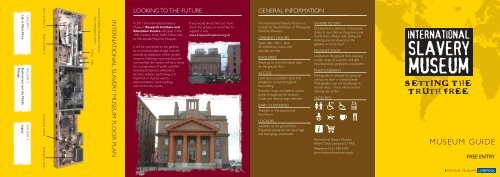
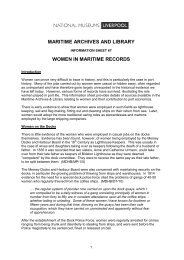
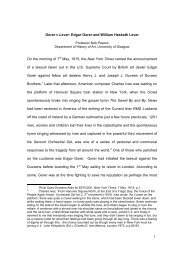
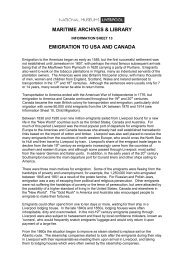
![Ancient Egypt trail [227kb .pdf] - National Museums Liverpool](https://img.yumpu.com/48998817/1/184x260/ancient-egypt-trail-227kb-pdf-national-museums-liverpool.jpg?quality=85)

